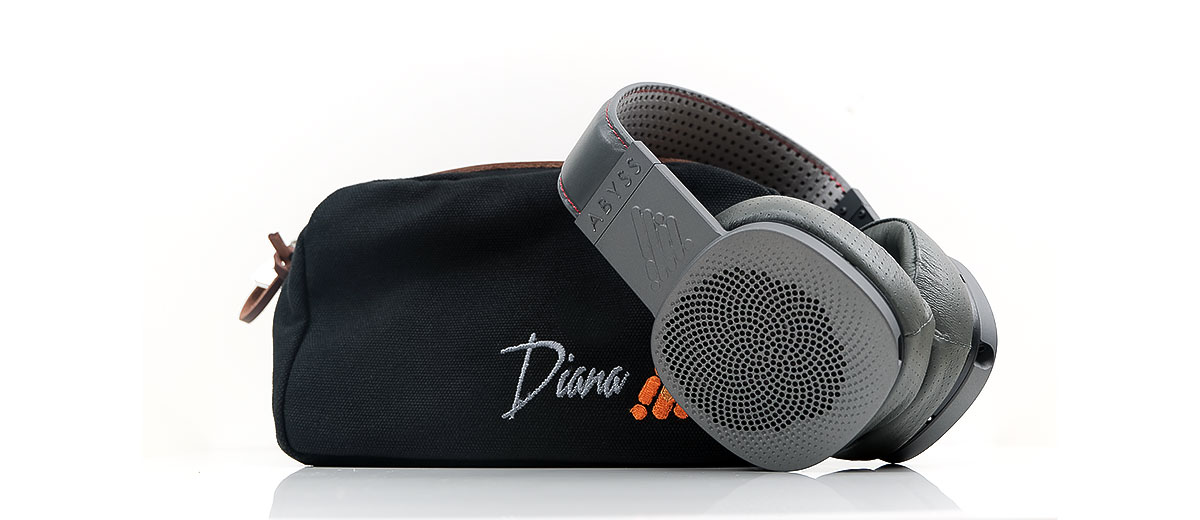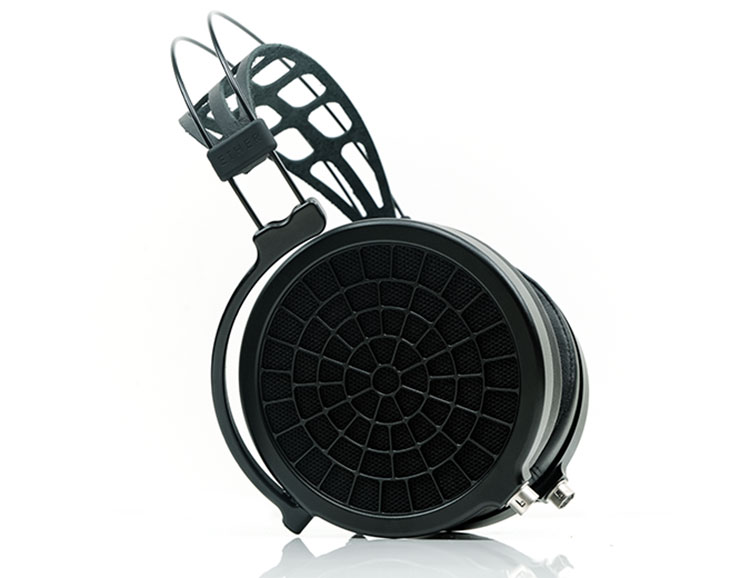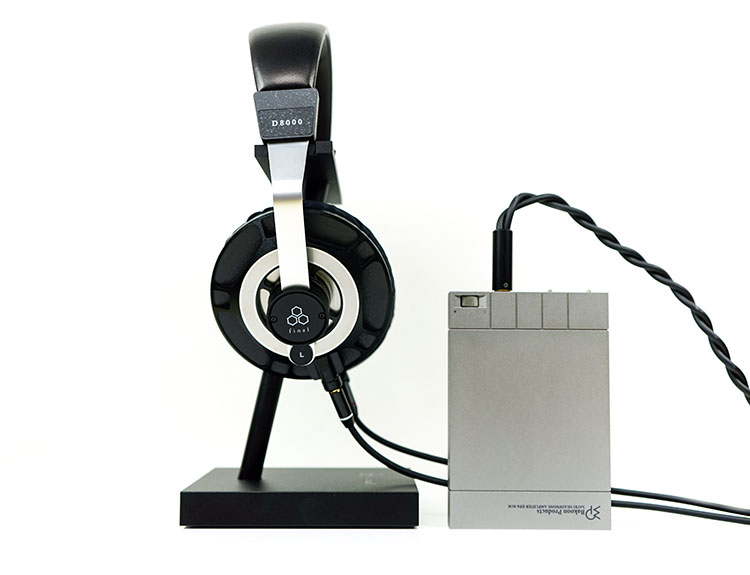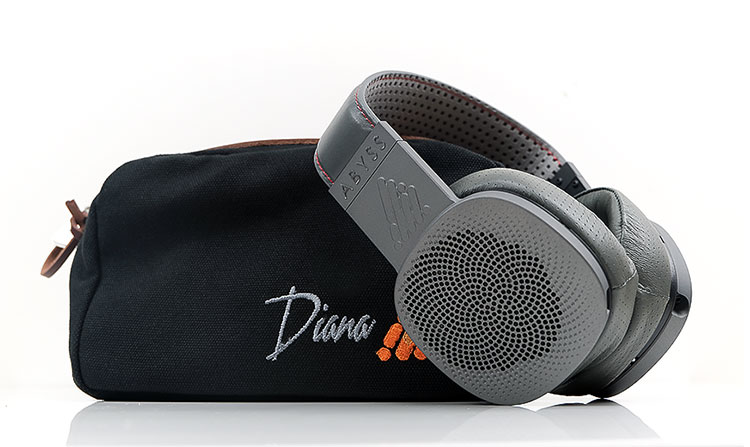Select Comparisons
Meze Empyrean
$2999
Technical
The Empyrean is in my top 3 this year for many a reason. It looks great, fabulously boutique much like the Diana Phi, but an entirely different visual aesthetic. One is exotic, grandiose, and almost Persian in styling. The other is 70’s retro, funky, and metropolitan in character.
Both are full-size open-back circumaural headphones but the Empyrean is much bigger and uses an isodynamic hybrid array planar from Rinaro whereas Abyss design and use their low-mass 63mm drivers. The Diana Phi is the more compact of the two, a little lighter, and gives off a definite if deceiving, portable headphone vibe.
Despite the additional 80g, the Empyrean is the slightly comfier of the two primarily due to those very thick leather or velour pads and the pre-formed or curved headband strap.
The pressure distribution does an amazing job of dissipating the weight of the Empyrean. The Diana Phi is also quite comfortable but you will be more aware of that thin headband padding pressure spot on your scalp, (unless you have a lot of hair then it’s fine).
Cables
Both are dual entry cable headphones with the Empyrean using a mini-XLR exit system and the Diana Phi a 2.5mm dual-mono variant.
These two choices are universal, however, the Empyrean has a small edge due to the narrow opening on the 2.5mm jacks on the Abyss. Both have good quality copper stock cables but I like the finish and lack of microphonics on the Abyss stock a little better.
Performance
The Empyrean is rated at 31.6Ω and 100dB SPL compared to the Diana Phi’s 32Ω and 91dB SPL. Impedance, (unless we are talking about the 200Ω LCD-4), is never really the driving concern of planar magnetic headphones; voltage for me plays a greater role as does current and the Diana Phi is the less efficient and more demanding of the two on that basis.
Most if not all headphone amps will drive the Empyrean quite easily, even down to resolving DAPs such as the Cayin N8 and the Lotoo PAW Gold Touch.
It will sound more resolving with the better dynamic range on full-scale desktop amps such as the Formula S but there is no way you can wire it to a speaker tap such as the TToby like you can with the Diana Phi.
Tuning
Two very different-sounding flagship headphones, each with some key strengths that I believe make them a worthy complement to each other.
The Empyrean is tuned a little darker than the Diana Phi and doesn’t have the same level of sparkle and presence in its treble. The Meze sound is more of a relaxing presentation with a richer timbre, a more forward smooth, and beguiling vocal presence with a low-end that delivers a lot more body and power albeit at a more languid pace.
The Diana Phi opts for something that is far more neutral in timbre to my ear with a very pacy level of articulation and incredible instrumental clarity from top to bottom. By and large, you will not get the same level of weight on the low-end as the Meze, though you do get a lot more treble extension, air, and more open midrange.
The Phi does have a little bump on the 1k marker for vocal presence but compared to the Empyrean it is not as pronounced. The Empyrean midrange bump also extends from 2-4k whereas the Phi is much more neutral in this region until you hit 4-5k.
Staging differences between these two headphones depend a little on your amp stage. I tend to find that on most DAPs and decent desktop amps the Empyrean has more depth and sub-bass presence or power.
However, once we started messing around with power amps like the TToby, the Diana Phi sub-bass was so well-defined and precise that it edged out the Empyrean in pure extension and definitely in height, if not quite in warmth.
Preferences
Picking between these two is going to come down to pure preference for me. If you want something a little more forgiving, perhaps more euphonic and generally offering more body and richness with beautiful vocals then pick the Empyrean.
If you want something more neutral, with an eye for detail, a pair of headphones that is pacy with excellent treble reach and air and can scale like no other, then pick the Diana Phi.
MrSpeakers Ether 2
$1999.99
Technical
Another top contender in our 2019 review sheet, the Ether 2 from MrSpeakers. This is a circumaural open-back planar magnetic headphone with a strong emphasis on weight reduction as well as a brand-new driver using V-Planar and TrueFlow from their original Ether Flow series.
The Ether 2 has a stylish and equally minimalist form factor but also a contrasting aesthetic from the Diana Phi. This is a matte black mix of aluminum, carbon fiber baffle, and that lovely Nitinol headband design with a pressure balancing strap. The Diana Phi is the smaller of the two and also uses a mix of aluminum and carbon fiber but still comes out a little heavier by 55g.
You can feel the difference on the head with the Ether 2 pressure displacement as good as the Empyrean and slightly better than the Diana Phi. The pads on both are an interesting contrast because for the first hour the Ether 2 original leather pads reign supreme.
After that, the Diana Phi is just as comfortable on the ear due to that slightly constrictive opening on the Ether 2 pads which tend to push down on the ear a little more than the shallower but wider opening on the Phi pads.
Cables
I am not a huge fan of Hirose connectors but they lock securely and seem very sturdy. Props though for the VOCE cable, in every way an upgrade on the DUM alternative from a few years back. It is quite a bit bulkier than the refined finish of the JPS Labs stock cable on the Diana Phi but both are 24AWG.
The wire is different on both cables with the VIVO using an SPC wiring compared to pure copper on the stock Diana Phi cable.
Performance
The Ether 2 is rated at 16Ω but there is no official SPL rating on their website. Based on our previous testing we found the Hifiman HE1000 V2 to be slightly less efficient than the Ether 2 which is rated at 35Ω and 90dB so we feel the Ether 2 probably has an SPL of around 92-94dB.
In our testing, the Phi was the more inefficient of the two but the gap between them was not as big as the Final D8000 or the Empyrean.
The Ether 2 will be more than happy driven from quality DAPs with good power such as the DX220/AMP1 MK11 and the Cayin N8 and there is a ton of headroom on desktop amps, even lower spec’d units like the Rupert Neve RHNP.
Tuning
A couple of big differences in the tuning of these two headphones. First is the timbre. The Ether 2 is a warmer or richer sounding headphone, with a little more low-end amplitude than the Diana Phi despite its very linear response from 20Hz up to 1K.
The Diana Phi strikes a more neutral tone, and a slightly leaner instrumental timbre exchanging low-end body and warmth for precision and better instrumental separation.
The Ether 2 treble also has a little more body and a slightly wetter attack compared to the cleaner and more energetic treble of the Diana Phi. As a result, the Phi is the airier sounding of the two with a bit more treble presence which in turn delivers a little more odd-harmonic overtone into its timbre.
The harmonic balance on the Diana Phi is more accurate to my ear but can also be less forgiving on poor setups or bright recordings compared to the Ether 2’s smoother euphonic delivery.
Staging
The second is staging. The Ether 2 sounds more upfront, slightly more intimate delivering more low-end aggression and body. Vocals are forward, rich, and creamy and can often be the focal point in the Ether 2’s signature.
The Diana Phi shoots for air, supreme instrumental separation, and trading body for speed and clarity. You will hear get a bit more height and more openness in its upper mids and lower treble compared to the Ether 2.
Vocals have more timbral accuracy but fall back a little in comparison to the Ether 2 so they are less of a focal point in the Phi’s staging.
Instead, your listening tends to take in both vocal and imaging cues from delicate cymbal brush strokes which have more presence than the Ether 2. I guess you can loosely term the presentation as more encompassing of what is happening on the stage with all the instruments and not just one key element.
Final Audio D8000
$3999
Technical
One of our favorite picks of 2018, the Final D8000 came out of nowhere and fast became a personal favorite of mine, especially with hard-rock blasting at full tilt. Like the rest of the line-up, this is a circumaural open-back planar magnetic headphone but it is our heaviest and biggest at 523g.
The D8000’s air-film damped driver is smaller at 50mm (moving part) compared to the larger 63mm of the Diana Phi. This is something you would never guess given their differences in physical size.
Everything about the D8000 is just that bit bigger, to be honest. despite its impeccable build quality I always found the bigger fit to not be the most comfortable and that’s its Achilles heel in an otherwise impeccable mix of aluminum, memory foam, and leather build quality.
The D8000 headband is simply too long for small heads meaning the pressure displacement tends to push down more than clamp side to side creating discomfort on the top of my ear for long listening sessions. You have to find the highest point of your scalp to mitigate that if you want longer or just simply have a bigger head than me.
This slight issue is exacerbated by the strange cloth cover on the memory foams which has a bit too much give allowing them to move a little too much for my liking. The Diana Phi, though thinner on the headband, has a little more reach that just about avoids that issue for me.
Cables
Both use dual entry jack systems on their cables but with the D8000 you get both a 1.5m and 3m of the same design in the package and 3.5mm instead of 2.5mm dual-mono connectors.
The first is a 3m twisted OFC wire with a black rubber jacket, terminated with a 3.5mm left and right-angle mono gold-plated screw-in jack on the connector side.
The second D8000 stock cable mirrors the first cable in terms of wire and twisted design, including the aluminum-finished barrels. However, it is much shorter at 1.5m and is terminated with a 3.5mm TRS jack.
However, both cables are unbalanced whereas you do have the choice of going balanced at the Diana Phi checkout. Both use copper conductors though the gauge for the D8000 stock is not published. I presume it is either 22 or 24AWG much like the Diana Phi cables.
Performance
The Final D8000 is rated at 60Ω and 98dB SPL. Ignore the double ohm count on the D8000 because compared to the Diana Phi’s 91dB SPL this is a more efficient and easier headphone to drive. The volume gap between the two on our tested amps was pretty substantial.
For example, on the Formula S, the D8000 was already getting punchy and very dynamic sounding at the same point the Diana Phi was still sounding a bit distant and soft. By the time we got the Diana Phi to proper levels, the D8000 was already way too loud. In contrast, our tested DAPs delivered more headroom and adjustable volume on the D8000 compared to the Phi.
Tuning
The D8000 is all about fun with a tuning that aims for more musical delivery and a bigger level of contrast between dollops of low-end power and upper treble sparkle. The Diana Phi is more evenly balanced and for my money has a more coherent reference-like signature.
One aspect that struck me most between these two, outside of the obvious low-end difference, was how more refined the treble is on the Diana Phi.
The D8000 treble is lively but more of an old-school style delivery with a slightly harder edge in its harmonic balance, particularly around 5-8k. The Phi’s treble, whilst also lively, seems to be more evenly balanced and not quite as spikey in its delivery with percussion and some vocal timbre.
Of course, the greatest difference is low-end elevation. The D8000 is elevated, much more so than the Diana Phi. You get much more depth and power with the D8000 right up to around 300-400Hz compared to the Diana Phi.
The Phi, by contrast, is much more linear with its emphasis on speed and articulation and keeping a more even transition into the mids. The D8000 mids are more muted or dipped whereas the Diana Phi is more neutral with a slight bump around 1-2k for better vocal presence.
The instrumental timbre on the D8000 is driven by that sub-bass power, excellent bass fundamental, and exciting treble contrast whereas the Diana Phi is more about accuracy and keeping things far more reference-like in both positioning and separation.
Our Verdict
The Diana Phi owns its flagship status with aplomb despite its funky almost cutesy visual aesthetic. It also presents an equally capable but decidedly different presentation to the likes of the Empyrean that make it almost the perfect complement to Meze’s masterpiece.
This is a TOTL detail specialist with a linear and finely balanced delivery that excels in presenting every aspect of any band’s performance without missing a single cue. Other headphones can suck you in with a single prominent aspect such as bass, vocals, or treble.
The Diana Phi balances that all out allowing you to appreciate almost every aspect of a musical performance, be it gentle acoustics or rapid old-school trance BPM’s.
In a way, listening to Diana Phi reminds me of my HE6 journey from 6-7 years ago with a more studied approach to finding the right amping and synergy. It is just full of welcome surprises the further up the chain you go and not once does it break a sweat and fall apart in a blaze of distortion.
Honestly, I am pretty sure there is even more potential in the Diana Phi with some DAC rotation and different amps and I have simply not found it just yet. That kind of lingering thought excites me a lot about a headphone and honestly, it is at the very core of why I love this hobby.
Abyss Headphones Diana Phi Specifications
- High-tech ceramic finish
- 63mm Phi planar drivers
- Impedance: 32 ohms
- Sensitivity: 91dB/mW
- Ultra-low mass diaphragm
- Magnetic EMotion headband
- Carry Case: Dual zipper canvas
- Plug: choice of 3.5, 2.5/4.4mm balanced, 4pin XLR
- JPS Labs Cables: 1.5m/5ft
- Titanium Grey Finish
- Weight: 350 grams
- 4.7 (94.4%) 25 vote[s]






